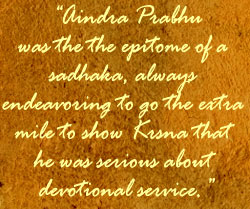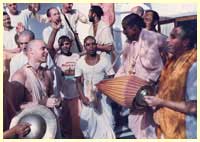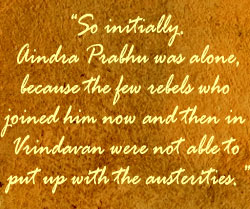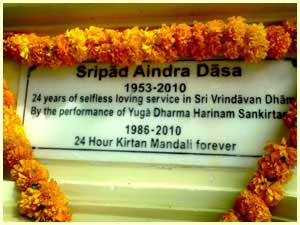 In
retrospect, one can easily conclude that Aindra Prabhu was
steadiness personified. He first
began Deity service in Washington D. C. in 1974, continued that
service on the Radha-Damodara Traveling Sankirtana Party, then
in New York City until 1986, and since then in Vrindavan.
Indeed, he left his body while preparing to cook for his Deities
in July 2010, and he surrendered his last breath at the lotus
feet of Lord Nityananda, to whom he had pledged his life.
In
retrospect, one can easily conclude that Aindra Prabhu was
steadiness personified. He first
began Deity service in Washington D. C. in 1974, continued that
service on the Radha-Damodara Traveling Sankirtana Party, then
in New York City until 1986, and since then in Vrindavan.
Indeed, he left his body while preparing to cook for his Deities
in July 2010, and he surrendered his last breath at the lotus
feet of Lord Nityananda, to whom he had pledged his life.
 Aindra Prabhu began leading
kirtanas in the
Washington D. C. temple, but after moving to New York City in
1981, he took the kirtana
into the street with a small mouse amplifier out on a hand cart.
One god-brother, Rasatala Prabhu, went out with him daily.
Later, after the devotees relocated to the present
Brooklyn temple in October 1982, Aindra Prabhu got a donation
from Bhavananda Prabhu, then co-GBC for New York. With that
money, Aindra Prabhu bought a panel box van. Using the basement
of the temple as a workshop, he made all the intricate artistic
designs that gradually transformed the truck into an ornate
golden temple. Early in the morning, he would drive to select
locations such as Broadway, Central Park, and Upper Manhattan
and sit there all day with his harmonium,
kirtana party, book
table, and “Changing Bodies” exhibit. In those areas, he aimed
at the business industry, and they responded favorably, amazed
to see the devotees sit in the same spot from 8 am to 5 pm every
day—just like they did in their offices. Impressed with the
devotees’ commitment, they would give donations, and some of
them felt inspired to take up the life of devotion.
One such person became Acyuta Dasa, known in
Aindra Prabhu began leading
kirtanas in the
Washington D. C. temple, but after moving to New York City in
1981, he took the kirtana
into the street with a small mouse amplifier out on a hand cart.
One god-brother, Rasatala Prabhu, went out with him daily.
Later, after the devotees relocated to the present
Brooklyn temple in October 1982, Aindra Prabhu got a donation
from Bhavananda Prabhu, then co-GBC for New York. With that
money, Aindra Prabhu bought a panel box van. Using the basement
of the temple as a workshop, he made all the intricate artistic
designs that gradually transformed the truck into an ornate
golden temple. Early in the morning, he would drive to select
locations such as Broadway, Central Park, and Upper Manhattan
and sit there all day with his harmonium,
kirtana party, book
table, and “Changing Bodies” exhibit. In those areas, he aimed
at the business industry, and they responded favorably, amazed
to see the devotees sit in the same spot from 8 am to 5 pm every
day—just like they did in their offices. Impressed with the
devotees’ commitment, they would give donations, and some of
them felt inspired to take up the life of devotion.
One such person became Acyuta Dasa, known in
 ISKCON for
having completed Srila Prabhupada’s
samadhi in Vrindavan. Every week, Aindra Prabhu would also go to
ethnic areas in Queens, such as Jackson Heights, which has a
high concentration of Indians and South Asians, and Ozone Park,
whose population is mostly Guyanese and Trinidadian. And he
would give them the Holy Names.
ISKCON for
having completed Srila Prabhupada’s
samadhi in Vrindavan. Every week, Aindra Prabhu would also go to
ethnic areas in Queens, such as Jackson Heights, which has a
high concentration of Indians and South Asians, and Ozone Park,
whose population is mostly Guyanese and Trinidadian. And he
would give them the Holy Names.
“Our
main business is to vibrate the Holy Name of Krishna everywhere
so that the people will be benefited by hearing the
transcendental sound. The musical training is not so important
as it is to keep ourselves spiritually fit in spiritual
strength, that we should not forget. If we are in spiritual
strength, there will be no scarcity of money; and the spiritual
strength is that each and every one of us must chant the sixteen
rounds of beads and follow the rules and regulations with great
adherence.” (Srila
Prabhupada's letter, Los Angeles
8 February, 1970)
 Aindra Prabhu was the epitome of a sadhaka,
always endeavoring to go the extra mile to show Krsna that he
was serious about devotional service.
For years he chanted one hundred thousand
names of God every day, and he gradually increased to two
hundred thousand. He also counseled devotees, studied the books
of Srila Prabhupada and the previous
acaryas, worshiped
Radhe-Shyam in the temple and his personal Deities in his room,
transformed the brahmacari
quarters into a transcendental art gallery, scrubbed the
toilets—and led the electrifying
kirtanas that won him
a place in devotees’ hearts the world over. Gradually, his
eating and sleeping dwindled to almost nothing. As the soft side
of his nature overtook the thunderbolt side, Krishna took him
away. Aindra Prabhu had proved his sincerity.
Aindra Prabhu was the epitome of a sadhaka,
always endeavoring to go the extra mile to show Krsna that he
was serious about devotional service.
For years he chanted one hundred thousand
names of God every day, and he gradually increased to two
hundred thousand. He also counseled devotees, studied the books
of Srila Prabhupada and the previous
acaryas, worshiped
Radhe-Shyam in the temple and his personal Deities in his room,
transformed the brahmacari
quarters into a transcendental art gallery, scrubbed the
toilets—and led the electrifying
kirtanas that won him
a place in devotees’ hearts the world over. Gradually, his
eating and sleeping dwindled to almost nothing. As the soft side
of his nature overtook the thunderbolt side, Krishna took him
away. Aindra Prabhu had proved his sincerity.
 The 24-hour kirtana revival began on the
Rama-vijaya-dasami of 1986. That day commemorates the
vijaya (victory) of Lord Ramacandra over the demon Ravana. But the
param vijayate, the
supreme victory, Lord Caitanya declared, is
sri krsna sankirtanam,
the loud chanting of the Holy Names of Krishna, because that
chanting conquers not only bad qualities but ultimately birth
and death as well. Not only that, but it is the life
of all transcendental knowledge. It increases the ocean of
transcendental bliss and enables us to fully taste the nectar we
always hanker for.
The 24-hour kirtana revival began on the
Rama-vijaya-dasami of 1986. That day commemorates the
vijaya (victory) of Lord Ramacandra over the demon Ravana. But the
param vijayate, the
supreme victory, Lord Caitanya declared, is
sri krsna sankirtanam,
the loud chanting of the Holy Names of Krishna, because that
chanting conquers not only bad qualities but ultimately birth
and death as well. Not only that, but it is the life
of all transcendental knowledge. It increases the ocean of
transcendental bliss and enables us to fully taste the nectar we
always hanker for.
And so, on the auspicious day of Rama-vijaya-dasami, the 24-hour
kirtana started under the auspices of Aindra Prabhu, and it remained
so for the next twenty-four years.
As Sri Caitanya Mahaprabhu took
sannyasa at the age of twenty-four and performed
sankirtana, both
publicly and privately, for the next twenty-four years, Aindra
Prabhu also journeyed to Vrindavan twenty-four years ago with
the intention of dedicating his body, mind, and soul to the
sankirtana
movement—which he did, also for a period of twenty-four years.
 It was not an overnight success. Until ten years ago, living in
Vrindavan throughout the year was a most difficult affair.
Especially in the summer. Especially on the third floor of the
Bhaktivedanta Swami Gurukula building. The electricity would go
on and off—as it still does—throughout the day and night,
sometimes for hours on end, and the generator would not be
switched on because the Gurukula was closed for the summer. And
because, even at night, the water just about steamed out of the
taps, there was no scope for refreshing showers. So, to muster
the strength to do anything more than lying in the pool of one’s
own sweat required great determination.
It was not an overnight success. Until ten years ago, living in
Vrindavan throughout the year was a most difficult affair.
Especially in the summer. Especially on the third floor of the
Bhaktivedanta Swami Gurukula building. The electricity would go
on and off—as it still does—throughout the day and night,
sometimes for hours on end, and the generator would not be
switched on because the Gurukula was closed for the summer. And
because, even at night, the water just about steamed out of the
taps, there was no scope for refreshing showers. So, to muster
the strength to do anything more than lying in the pool of one’s
own sweat required great determination.
 Throughout the 1980s in the ISKCON world,
sankirtana mostly
meant going out selling Hong Kong paintings—or whatever
generated the most profit—and the obedient devotees were thus
engaged. So initially, Aindra Prabhu was alone, because the few rebels who
joined him now and then in Vrindavan were not able to put up
with the austerities. Not only the weather was difficult,
but there was no money for maintenance. Aindra Prabhu had to pay
rent for his rooms at the Gurukula, pay for his
kichari prasadam—pay
for everything he needed to maintain his and his crew’s body and
soul together. At one point, the temple president decided to
hire professional
kirtaneers to strengthen the kirtana party. But these
persons competed for name and fame, not for
bhakti, and Aindra Prabhu dismissed them.
Throughout the 1980s in the ISKCON world,
sankirtana mostly
meant going out selling Hong Kong paintings—or whatever
generated the most profit—and the obedient devotees were thus
engaged. So initially, Aindra Prabhu was alone, because the few rebels who
joined him now and then in Vrindavan were not able to put up
with the austerities. Not only the weather was difficult,
but there was no money for maintenance. Aindra Prabhu had to pay
rent for his rooms at the Gurukula, pay for his
kichari prasadam—pay
for everything he needed to maintain his and his crew’s body and
soul together. At one point, the temple president decided to
hire professional
kirtaneers to strengthen the kirtana party. But these
persons competed for name and fame, not for
bhakti, and Aindra Prabhu dismissed them.
 Purity is the force. And indeed, quality men began to feel
attracted to joining Aindra Prabhu’s program during their visits
to Vrindavan. (…) Materially speaking, the 24-hour
kirtana slowly went
from abject poverty to relative comfort. When the responsible
devotees mentioned above started trickling in, they began
recording Aindra Prabhu's
kirtanas, took them back to the West, and sold the cassettes
to other devotees. And they would bring back the proceeds to
Vrindavan whenever they returned.
Although Aindra Prabhu was a simple sadhu deeply immersed in his
internal meditation in Vrindavan, he was also very merciful to
the conditioned souls, wanting them to get the great treasure of
the holy name. So he did produce several cassette albums for
the transcendental
Purity is the force. And indeed, quality men began to feel
attracted to joining Aindra Prabhu’s program during their visits
to Vrindavan. (…) Materially speaking, the 24-hour
kirtana slowly went
from abject poverty to relative comfort. When the responsible
devotees mentioned above started trickling in, they began
recording Aindra Prabhu's
kirtanas, took them back to the West, and sold the cassettes
to other devotees. And they would bring back the proceeds to
Vrindavan whenever they returned.
Although Aindra Prabhu was a simple sadhu deeply immersed in his
internal meditation in Vrindavan, he was also very merciful to
the conditioned souls, wanting them to get the great treasure of
the holy name. So he did produce several cassette albums for
the transcendental
 pleasure of the devotees. To produce music in Vrindavan is no small feat, but for the sake of authenticity, Aindra Prabhu went through the ordeal. And so, the sound of peacocks, parrots, and other Vrindavan living entities mingles
charmingly with the sound of Aindra Prabhu’s enchanting songs on
albums such as “Cintamani-nama”, “Vrindavan Mellows”, and
others. As Aindra
Prabhu’s transcendental fame grew, well-to-do devotees felt
inspired to contribute to the maintenance of the 24-hour
kirtana party.
But Aindra Prabhu was not
interested in living comfortably, and whenever the occasion
arose, he would give donations to the temple. (...)
pleasure of the devotees. To produce music in Vrindavan is no small feat, but for the sake of authenticity, Aindra Prabhu went through the ordeal. And so, the sound of peacocks, parrots, and other Vrindavan living entities mingles
charmingly with the sound of Aindra Prabhu’s enchanting songs on
albums such as “Cintamani-nama”, “Vrindavan Mellows”, and
others. As Aindra
Prabhu’s transcendental fame grew, well-to-do devotees felt
inspired to contribute to the maintenance of the 24-hour
kirtana party.
But Aindra Prabhu was not
interested in living comfortably, and whenever the occasion
arose, he would give donations to the temple. (...)
“He [Aindra Prabhu] was such a fixture in Vrindavan that one could take
him for granted, assume that he would always be there. And he
was always there, in the same place, doing the same thing, even
looking the same. He never seemed to age. He was such a constant
presence in Vrindavan, in the Krishna-Balarama temple, in the
twenty-four hour kirtana,
that I for one never imagined what the
kirtana or the temple
or Vrindavan would be without him, what life would be without
him. He was like the oxygen we breathe. It is always there, so
we don't think about it. But it gives us life.” (His Holiness Giriraj Swami)
 Aindra Prabhu had the potency to stay in one place and affect
the world, but those who travel can also affect the world.
The real point is the intensity of purpose: letting go of petty,
mundane attachments, and focusing on our goal. This is Aindra
Prabhu’s example and our challenge. And we can take heart from
the example of Srila Bhaktivinoda Thakura, who preached
vigorously in Bengal and fought against many deviant sects but
later became discouraged because the deviant groups he had
fought to expose, and whom he had subdued for some time, were
coming back again. In his despondent state, he had a dream in
which Caitanya Mahaprabhu told him to go to Jagannatha Puri and
establish a bhajana-kutira near Haridasa Thakura's
samadhi and just chant
the holy names there. His chanting, Mahaprabhu told him, would
purify the whole world.
Aindra Prabhu had the potency to stay in one place and affect
the world, but those who travel can also affect the world.
The real point is the intensity of purpose: letting go of petty,
mundane attachments, and focusing on our goal. This is Aindra
Prabhu’s example and our challenge. And we can take heart from
the example of Srila Bhaktivinoda Thakura, who preached
vigorously in Bengal and fought against many deviant sects but
later became discouraged because the deviant groups he had
fought to expose, and whom he had subdued for some time, were
coming back again. In his despondent state, he had a dream in
which Caitanya Mahaprabhu told him to go to Jagannatha Puri and
establish a bhajana-kutira near Haridasa Thakura's
samadhi and just chant
the holy names there. His chanting, Mahaprabhu told him, would
purify the whole world.
So there is great value in sitting in one
place and just chanting purely the Holy Names for the benefit of
humanity. At least for some time every year, we request the
members of our worldwide community of devotees to donate some of
their time and energy to the 24-hour kirtana in Vrindavan—a few
days, a few weeks, a few months, whatever you can give, please
give it wholeheartedly for the spiritual upliftment of the
world. (...) Yad yad
acarati sresthas…The
legacy goes on.


 Aindra Prabhu was the epitome of a sadhaka,
always endeavoring to go the extra mile to show Krsna that he
was serious about devotional service.
For years he chanted one hundred thousand
names of God every day, and he gradually increased to two
hundred thousand. He also counseled devotees, studied the books
of Srila Prabhupada and the previous
acaryas, worshiped
Radhe-Shyam in the temple and his personal Deities in his room,
transformed the brahmacari
quarters into a transcendental art gallery, scrubbed the
toilets—and led the electrifying
kirtanas that won him
a place in devotees’ hearts the world over. Gradually, his
eating and sleeping dwindled to almost nothing. As the soft side
of his nature overtook the thunderbolt side, Krishna took him
away. Aindra Prabhu had proved his sincerity.
Aindra Prabhu was the epitome of a sadhaka,
always endeavoring to go the extra mile to show Krsna that he
was serious about devotional service.
For years he chanted one hundred thousand
names of God every day, and he gradually increased to two
hundred thousand. He also counseled devotees, studied the books
of Srila Prabhupada and the previous
acaryas, worshiped
Radhe-Shyam in the temple and his personal Deities in his room,
transformed the brahmacari
quarters into a transcendental art gallery, scrubbed the
toilets—and led the electrifying
kirtanas that won him
a place in devotees’ hearts the world over. Gradually, his
eating and sleeping dwindled to almost nothing. As the soft side
of his nature overtook the thunderbolt side, Krishna took him
away. Aindra Prabhu had proved his sincerity. In
retrospect, one can easily conclude that Aindra Prabhu was
steadiness personified.
In
retrospect, one can easily conclude that Aindra Prabhu was
steadiness personified.



 Throughout the 1980s in the ISKCON world,
sankirtana mostly
meant going out selling Hong Kong paintings—or whatever
generated the most profit—and the obedient devotees were thus
engaged.
Throughout the 1980s in the ISKCON world,
sankirtana mostly
meant going out selling Hong Kong paintings—or whatever
generated the most profit—and the obedient devotees were thus
engaged. Purity is the force. And indeed, quality men began to feel
attracted to joining Aindra Prabhu’s program during their visits
to Vrindavan. (…) Materially speaking, the 24-hour
kirtana slowly went
from abject poverty to relative comfort. When the responsible
devotees mentioned above started trickling in, they began
recording Aindra Prabhu's
kirtanas, took them back to the West, and sold the cassettes
to other devotees. And they would bring back the proceeds to
Vrindavan whenever they returned.
Purity is the force. And indeed, quality men began to feel
attracted to joining Aindra Prabhu’s program during their visits
to Vrindavan. (…) Materially speaking, the 24-hour
kirtana slowly went
from abject poverty to relative comfort. When the responsible
devotees mentioned above started trickling in, they began
recording Aindra Prabhu's
kirtanas, took them back to the West, and sold the cassettes
to other devotees. And they would bring back the proceeds to
Vrindavan whenever they returned.

 Aindra Prabhu had the potency to stay in one place and affect
the world, but those who travel can also affect the world.
Aindra Prabhu had the potency to stay in one place and affect
the world, but those who travel can also affect the world.